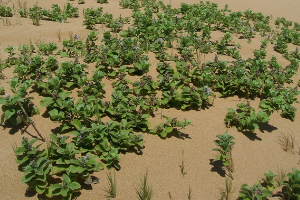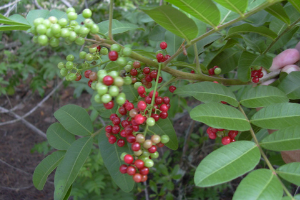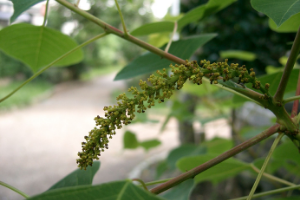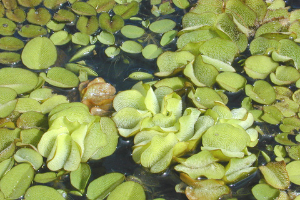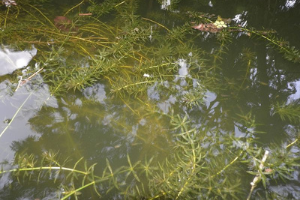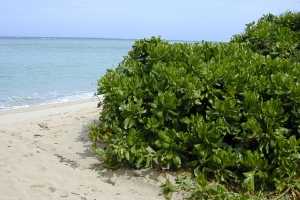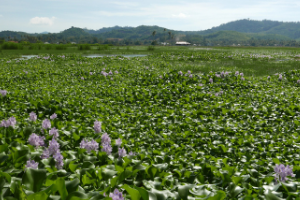| Photo | Species | Home Range | Problem | Management |
|---|---|---|---|---|
| Air Potato Dioscorea bulbifera | Tropical Asia | Can grow 8”/day, can grow to the tops of trees and take over native plants | Removing by hand does occur but can cause damage to the tree it is being removed from. There is an approved biological agent (the air potato beetle – Lilioceris cheni – effective, contact your county extension office on how to obtain them, Chemical treatments with dilutions of triclopyr or glyphosate are effective, but retreatments are probably necessary. Contact extension office for recommended concentrations. More information More information |
|
| Alligator Weed Alternanthera philoxeroides | South America | Can grow on land or water, develops large mats that expand across the surface of water | Biological controls include: Alligator weed beetle – Agasicles hygrophila Alligator weed thrips (recommended) – Amynothrips andersoni More information More information |
|
| Beach Vitex Vitex rotundifolia | Pacific coast of Asia | Grows in open coastal areas, is allelopathic and replace native plants, could impact sea turtle nesting and beach mice ecology | Mechanical removal of the taproot is effective Chemical treatment would include dilutions of glyphosate. More information More information |
|
| Brazilian Pepper Schinus terebinthifolius | Argentina, Paraguay Brazil | Very aggressive, shades out native plants reduces habitat for native animals, can tolerate waters greater than 20 ppt. | Mechanical methods can work if you get all roots ¼” in diameter or more, fire will kill tree and seeds but not roots, Foliar application of triclopyr or glyphosate on smaller trees may work, the same products can be used on a stump after cutting, there is a biological control available now. More information More information |
|
| Chinese Tallow Triadica sebifera | Asia | It spreads aggressively along “edges”. Will grow in open or shade conditions and even in marine habitats. | Remove small seedlings by hand as the emerge. Larger trees can be cut to a small stump and treated chemically, or a trunk cut can be done and apply chemical this way. The chemical of choice is triclopyr. To obtain the recipe for the herbicide, and when to conduct the cut-spray, contact your county extension office. More information More information |
|
| Cogongrass Imperata cylindrica | Southeast Asia | Spreads aggressively, grows well in low nutrient soils, serrated and not preferred by livestock, can enhance prescribed burns to temperatures that can kill trees | In non-crop areas prometon, tebuthiuron, and imazapyr have been effective – however, no vegetation will re-grow for several months. For other areas dilutions of glyphosate, Fluazifop, Fusilade is a selective grass herbicide that provide have had some success, but they are non-select herbicides. An integrated plan using burning, tillage, and chemical treatments seem to work best. Contact your extension office for more details on how to mix these. More information More information |
|
| Eurasian Watermilfoil Myriophyllum spicatum | Eurasia or Africa | Develops large mats which blog sunlight and reduces benthic plant growth. It can impact birds and fish. | Mechanical “choppers” can be used but remaining fragments will bring problem back. Some have used this method along with an underwater vacuum. Periodic water drawdowns have helped. Some biocontrol fish have been used and a variety of chemical treatments, including formulations of endothall, diquat, copper, 2,4-D, and fluridone. Certifications are needed, you should contact your county extension office for large problems. More information More information |
|
| Giant Salvinia Salvinia molesta | Southeastern Brazil | Forms large mats on the surface of quiet freshwater ponds. Will block sunlight, cause native plant die-off, and lower dissolved oxygen. | Removing by hand with hand nets works with small amounts. Other states have used a beetle (Cyrtobagous salvinae) to control. Large infestations should be reported to FWC. More information More information |
|
| Hydrilla Hydrilla verticillata | Southern India | The plant grows towards the surface then spreads vertically forming large mats and blocking sunlight. This decreases native plant diversity. It slows water flow and clogs irrigation and flood-control canals, as well as pumping stations. It can also impact recreational activities in waterways. | Waterway drawdowns can help. Mechanical “choppers” can remove large amounts but leave fragments behind. Chinese grass carp have been effective. Chemical treatments have provided temporary relief. Registered herbicides with copper, diquat, endothall or fluridone have had some success. Many of these require certification, contact your county extension office for more on these herbicides. More information More information |
|
| Naupaka Scaevola taccada | East Africa, India, Australia, Polynesia | Displacing native beach plants. | More information More information |
|
| Torpedo Grass Panicum repens | Africa Asia | Very aggressive, spread over 70% of Florida’s public waters, management costs are near $2 million annual for flood control, can tolerate water greater than 20 ppt. | Mechanical removal is moderately successful and can – in some cases – increase the problem, Glyphosate is the most effective chemical treatment (there is an aquatic version of this product), best preventive measure is not moving the rhizomes while mowing – even small fragments can start and invasion and waterways are most vulnerable. More information More information |
|
| Water Hyacinth Eichhornia crassipes | South America | Clogs waterways making boat travel hard, decreasing dissolved oxygen, lowers biodiversity, costs millions to manage in Florida each year. | Mechanical “choppers” are more effective on this plant than other surface invasive species. There are two weevils that have been somewhat effective but herbivorous fish have not. Registered herbicides do provide temporary relief. Check with your county extension which chemicals and rules on application. More information More information |
|
| Wild taro Colocasia esculenta | Asia | Grows in dense patches along waterways. The large leaves can block sunlight and decrease native plant diversity. | They can be removed by hand and shovel, but care should be taken due to the presence of oxalic acid in the leaves, which can be irritating to the skin. Some have had success with 2% glyphosate. More information More information |
Showing 1 to 13 of 13 entries
Resources:
University of Florida IFAS Assessment of Non-Native Plants in Florida’s Natural Areas – https://assessment.ifas.ufl.edu/.
Efficacy of Herbicide Active Ingredients Against Aquatic Weeds – http://edis.ifas.ufl.edu/pdffiles/AG/AG26200.pdf.
University of Florida Center for Aquatic and Invasive Plants – http://plants.ifas.ufl.edu/.



